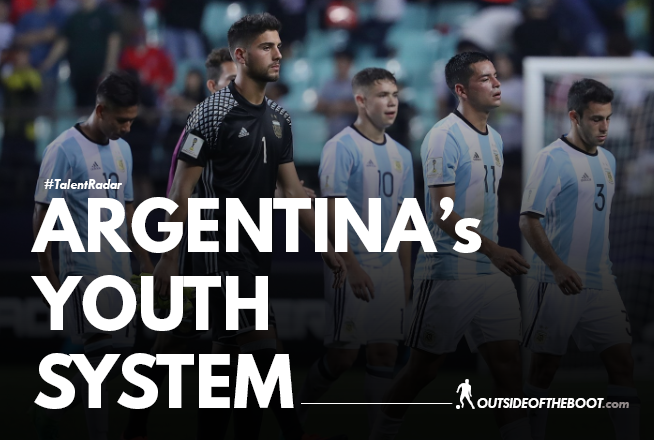Tom Robinson has a look at Argentina’s worrying record in the recent editions of the U-20 World Cup and the sorry state of the country’s youth system.
Argentina continued their dismal recent record at U20 World Cups after yet another sobering early exit from this year’s tournament in South Korea. Despite a resounding 5-0 victory against Guinea, it proved too little too late as results elsewhere meant that the Albiceleste missed out on qualifying as one of the best third-placed sides.
Argentina’s record in recent years now makes for grim reading. The last two editions have seen them crash out at the group stage and they failed to even qualify at all in 2009 and 2013. A quarter-final appearance in 2011 has been the sole highlight of the last decade.
Compare that with the period directly before and the downturn in form is put into stark contrast. Between 1995 and 2007 Argentina won five out of seven U20 World Cups under the guidance of first Jose Pekerman and then Hugo Tocali and Francisco Ferraro.

That golden generation brought through future stars who would go on to become the backbone of the senior national team. Juan Pablo Sorin, a champion at Qatar 1995, went on to make 76 caps for Argentina, while the 1997 side included names such as Juan Roman Riquelme, Esteban Cambiasso and Pablo Aimar. Javier Saviola was top scorer in the 2001 edition; a 17-year-old Lionel Messi starred in 2005; and 2007 saw the likes of Sergio Aguero, Ever Banega and Angel di Maria emerge victorious in Canada.
So where has this dramatic fall from grace come from? Certainly the players on show in South Korea were one of the more underwhelming crops in recent memory. Lautaro Martinez and Santiago Ascacibar are perhaps the only players with genuine star potential, while Tomas Conechny, Brian Mansilla and Santiago Colombatto look like interesting prospects, but beyond that there wasn’t much else to get excited about.
While the strikers were able to bail them out as they scraped through the Sudamericano in February, Argentina were made to pay for their profligacy in front of goal and inability to up their tempo as they slumped to defeats against England and hosts South Korea. Although they looked good in possession (57.6% on average) and lacked a bit of luck, they nevertheless failed to capitalise on their chances and were too porous at the back, ultimately justifying the low expectations going into the tournament.

Santiago Ascacibar is one of the few exciting prospects from the U-20 World Cup squad (Photo credit: JUAN CEVALLOS/AFP/Getty Images)
But the problems run deeper than merely the personnel on show. Even when Argentina have been able to field stronger squads, the results have been equally disappointing. The 2015 squad that also went out at the group stage included the likes of Angel Correa, Gio Simeone, Cristian Pavon and Emanuel Mammana. What’s more, the 2013 side didn’t qualify from the Sudamericano on home soil despite having the talents of Manuel Lanzini, Ricky Centurion, Alan Ruiz, Lucianno Vietto, Juan Iturbe and Matias Kranevitter to call upon.
Simply put, Argentina continues to produce talent in spite of its youth system not because of it.
This long period of underachievement at youth level can be directly attributed to the ongoing off-the-field chaos at the Argentinian Football Association. After the success laid by the solid foundations of Pekerman, the AFA have rested on their laurels, neglecting the youth divisions and failing to implement any long-term strategy. Eventually this will surely come back to haunt the national team.
Stories of incompetence abound. From the fact that Claudio Ubeda was given the role of U20 manager despite not being one of the 44 coaches to submit a project to the AFA, to the farcical preparations for the 2014 Olympics in Rio when Julio Olarticoechea lamented the fact there wasn’t even food for the players at their training ground, the AFA lurches from one embarrassment to the next.
A dearth of defensive talent being produced has long been an issue for the top-heavy Argentina teams at all levels. Perhaps this is a consequence of the economic reality of clubs being able to make more money from selling a flashy attacking talent than a defender, but what’s for certain is that the AFA have not been able to address this enduring problem.
There may be a glimmer of light at the end of the tunnel though. Juan Sebastian Veron has been instated as the head of the country’s youth divisions, bringing hope of an extensive, forward-thinking reconstruction of the youth system. The examples of Uruguay and Venezuela have shown, with far less resources and infrastructure, what a long-term plan can achieve and Veron’s good track record as President of Estudiantes and experience in Europe should bode well. Names such as Pablo Aimar, both Milito brothers, Jorge Burruchaga and Hermes Desio being heavily involved suggest a break from the past and a reason for positivity.
In the wake of defeat, Ubeda called for patience – one he recognises barely exists in the short-termism of Argentina football – if the youth teams are to get back to their glory days. Hopefully this latest failure will finally be the wake-up call to rouse the AFA from its protracted navel-gazing and Veron’s appointment can be the first forward step on this long road to recovery.
You can find more at @tomrobbo89
- 2020 Argentinian Primera: Young Players To Watch - November 26, 2020
- Scout Report: Agustin Urzi | Banfield And Argentina Winger - October 13, 2020
- 2020 Brasileirao’s 10 Young Players To Watch - September 10, 2020
























































